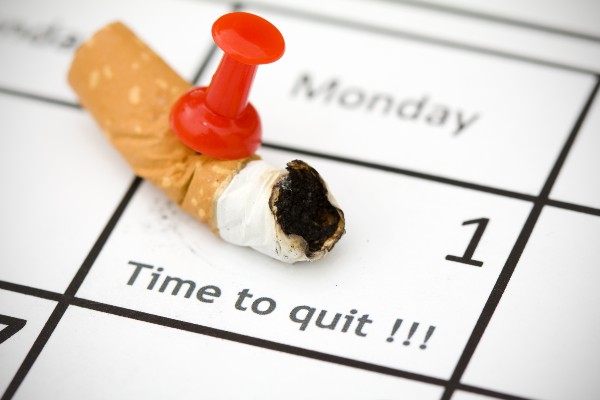Quitting smoking is hard, but millions of people have managed to do it, and their experiences can help you quit successfully too. Whether you are dependent on cigarettes, smokeless tobacco or e-cigarettes, there are resources available to help you kick the habit and take your health back in your own hands.
Some excellent online sources include the American Cancer Society, the Centers for Disease Control and Prevention and Smokefree.gov. The Smokefree site has special materials for specific groups of people including teens, veterans, women, and individuals 60+ as well as materials in Spanish.
1. Know your reasons for quitting
Your reasons for quitting may be for better health, for your family or for your wallet. But, whatever your reasons – identify WHY you have decided to commit to quit. Write your reasons down and put them somewhere accessible where you can quickly read them when you face a craving and are tempted to smoke. Some people make a list on paper or their phones, and others find taking a picture of the people or pets they are doing this for to be helpful.
2. Make a commitment to quit and put your quit day on your calendar
Pick a day to quit. Don’t make it so far out that you can change your mind, but give yourself the time you need to prepare to quit. You could choose a date like the Great American Smokeout the third Thursday in November or a date that has personal meaning to you such as an anniversary or birthday.
3. Tell your friends and family and ask them to help you
Quitting is hard, and having the support of your family, friends or coworkers can help. They can be there to offer encouragement, help distract you from cravings and remind you of your reasons for quitting when you are tempted to reach for a cigarette.
4. Develop your quitting strategy and set up support
There are different approaches to quitting. Some individuals find nicotine replacement therapy or other medications helpful in transitioning away from reliance on cigarettes. Consider setting up an appointment with your primary care provider to understand what tools they may be able to help you with. Support groups and counseling have also been noted as helpful tools for many people in their quest to quit. There are many online resources that can also be helpful, including online apps and texted daily reminders. Other successful quitters have found that oral substitutes are helpful to keep their mouth busy with something other than a cigarette. Before your Quit Day, stock up on oral substitutes you may need, such as sugarless gum, hard candy, toothpicks, straws, coffee stirrers or straws.
You should also decide how you are going to quit. There are three different approaches, and you can determine which will work best for you. One common approach is to quit all at once, often called “Cold Turkey.” Another approach is to slowly reduce the number of cigarettes each day until you are down to zero. The third approach is to force a delay every time you have a craving, making that time longer and longer over time or by refusing to smoke after selected triggers.
5. Identify your triggers
Each person reaches for a cigarette for their own unique reason. What is it that triggers you? Stress? Going out to a bar with friends? Boredom? Morning coffee? Arguing with a family member?
Think about what triggers a craving and determine if you could avoid that situation or change part of the routine. For example, could you eat breakfast in a different part of the house? Go for a brief walk midday instead of a smoke break? Go to a movie with friends instead of a bar where there will be a lot of other smokers?
6. Remove reminders of smoking
Before your Quit Day, take time to remove all reminders of smoking. This can include removing ash trays, packs of cigarettes and / or lighters from your home, your car and your work space.
7. Stay busy and stay positive
Especially at the beginning, it may be important to find ways to stay busy so you aren’t tempted to reach for a cigarette. When you plan your Quit Day, consider making plans for that day that will help support this change. Ideas for staying busy could include scheduling plans to meet friends for dinner at a location where you know there won’t be any smokers. Or plan to attend a movie or sporting event. Throughout your quitting journey find small ways to keep your mind and body occupied when you want to have a smoke. Ideas that have worked for others include brief walks, meditation, yoga poses, calling friends, drinking lots of water, reaching for oral substitutes or keeping hands busy with pens, keys or some other fidget item.
8. Work through withdrawal symptoms
Studies show 80-90% of smokers are addicted to nicotine. Unless you are lucky enough to be in that 10% who aren’t addicted, you will most likely experience some physical symptoms as your body learns to operate without the regular doses of nicotine. While you may not feel well during this time, know that there is nothing physically dangerous about nicotine withdrawal. In fact it is one of the best things you can do for your health.
Nicotine is a stimulant, so removing that will impact different parts of the body. You may be tempted to reach for more caffeine during this time, but that will make you feel more jumpy and jittery. Drinking a lot of water, eating right with lots of fiber, regular exercise and maintaining a regular sleeping schedule can help fight the symptoms. Some people find medication helpful in lessening these symptoms. Speak to your primary care provider about whether medication to ease withdrawal might help you be successful in quitting.
Withdrawal symptoms can last a few days to a few weeks. Common symptoms of withdrawal include:
- Craving cigarettes
- Increased appetite
- Cough
- Headaches and dizziness
- Constipation
- Fatigue and / or having trouble sleeping
- Varying emotions, including increased irritability or sadness
- Feeling jumpy, jittery or restless
- Having trouble concentrating, staying focused or thinking clearly
9. Don’t give up if you slip up
If you slip up and have a cigarette don’t let it be the end of your quitting journey. Learn from the mistake and keep trying. Remind yourself why you are quitting and quit again immediately – either that same day or the next day.
Look at what made you slip up and brainstorm ways to avoid the same trigger in the future or find other ways to manage the situation. Don’t beat yourself up. Don’t get discouraged. Dust yourself off and get back on track.
10. Celebrate each achievement
Recognize the small victories along the way. Consider what might be the most meaningful way to do so for you. Crossing each day smoke-free off a calendar? Each week?
Put the money you would have spent on cigarettes aside and splurge on rewards. Experts estimate the average smoker spends $2,000 - $4,000 a year on cigarettes. If you put aside the money you would have spent on cigarettes aside and splurge on some rewards as you quit. What would make you happy? A massage? New video game? Night out with friends? Tickets to a ball game?
You’ve worked hard to quit smoking. Take time to feel proud of what you’ve accomplished and celebrate your achievements!



